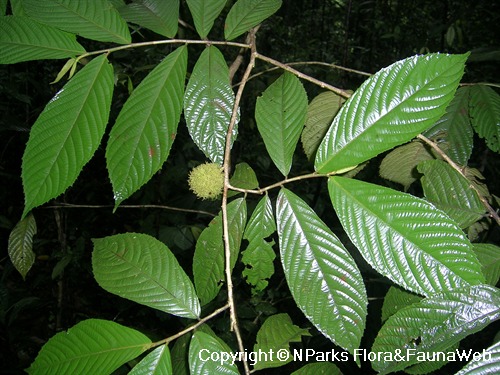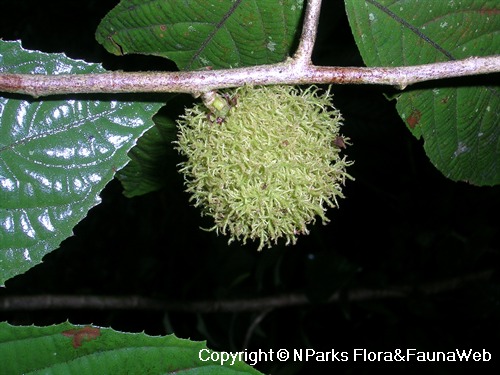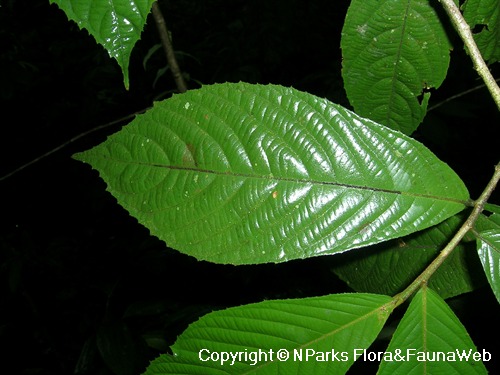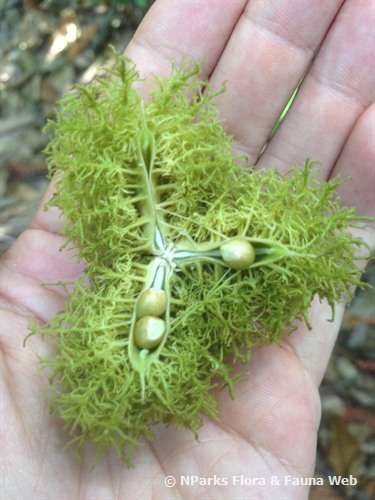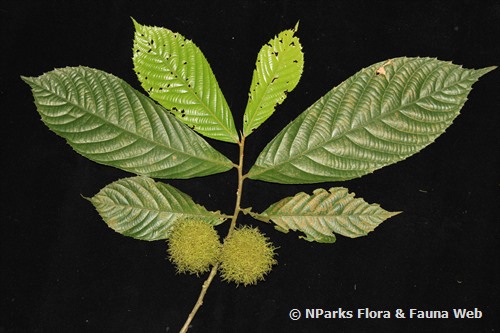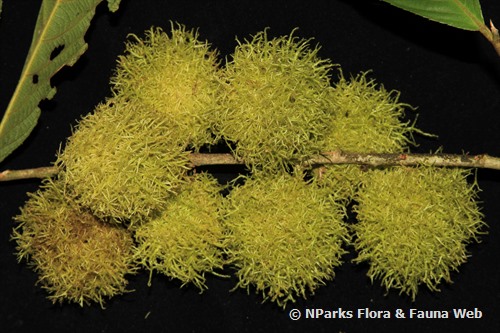
Back
Rinorea anguifera (Lour.) Kuntze
| Family Name: | Violaceae |
| Synonyms: | Hymenanthera echinocarpa |
| Common Name: | Sebilek, Kayu rembut |
Name
Classifications and Characteristics
| Plant Division | Angiosperms (Flowering Seed Plants) |
|---|---|
| Plant Growth Form | Tree, Shrub |
| Maximum Height | 10 m |
Biogeography
| Native Distribution | Sumatra, Thailand, Indochina, Peninsular Malaysia, Singapore, and Borneo |
|---|---|
| Native Habitat | Terrestrial |
| Preferred Climate Zone | Tropical |
| Local Conservation Status | Native to Singapore (Critically Endangered (CR)) |
Description and Ethnobotany
| Growth Form | It is a shrub or tree that grows up to 10 m tall. Its young twigs are densely covered with brown hairs. |
|---|---|
| Foliage | Its spirally arranged, stalked leaves have thinly leathery leaf blades that are drop-shaped, and 7–37 by 2.7–11 cm. The leaf blades have toothed margins that vary in size. |
| Flowers | Up to 20 flowers are found in dense, almost stalkless clusters arising from the leaf axils of side branches. These flowers are mostly white to sometimes yellow, and facing upwards from the lateral branches. |
| Fruit | Its fruit is round, up to 3.5 cm wide, and covered in a dense mass of branched hairs before splitting open. Each fruit contains up to 6 seeds that are egg-shaped, glossy, straw-coloured, and 4–7 mm long. |
| Habitat | It grows in primary or secondary forests, in humid places, in the lowlands up to 600 m altitude. It occurs locally in the vicinity of the Upper Peirce Reservoir and MacRitchie Reservoir. |
| Associated Fauna | Its flowers are insect-pollinated. It is also the preferred local food plant for caterpillars of the butterfly, the royal Assyrian (Terinos terpander robertsia), the adult of which lays its eggs singly on the undersides of the leaf blades. |
| Cultivation | It can be propagated by seed. |
| Etymology | Latin Rinorea, from a Guyanese vernacular name; Latin anguis, snake; Latin ferre, to bear, referring to the twisted hairs on the fruits |
Fauna, Pollination and Dispersal
| Fauna Pollination Dispersal Associated Fauna | Butterfly Host Plant |
|---|
Plant Care and Propagation
| Light Preference | Semi-Shade, Full Shade |
|---|---|
| Water Preference | Moderate Water |
| Plant Growth Rate | Moderate |
Foliar
| Mature Foliage Colour(s) | Green |
|---|---|
| Mature Foliage Texture(s) | Leathery |
| Leaf Area Index (LAI) for Green Plot Ratio | 3.0 (Tree - Intermediate Canopy) |
Floral (Angiosperm)
| Flower Colour(s) | Cream / Off-White |
|---|
Fruit, Seed and Spore
| Mature Fruit Colour(s) | Green |
|---|
References
| References | Jacobs, M. & D. M. Moore. 1971. Violaceae. Flora Malesiana. Series I, 7: 179−212 Ng, F. S. P.. 1978. Violaceae. Tree Flora of Malaya. Volume 3. 314−321 |
|---|
Image Repository
Others
| Master ID | 1810 |
|---|---|
| Species ID | 3103 |
| Flora Disclaimer | The information in this website has been compiled from reliable sources, such as reference works on medicinal plants. It is not a substitute for medical advice or treatment and NParks does not purport to provide any medical advice. Readers should always consult his/her physician before using or consuming a plant for medicinal purposes. |

